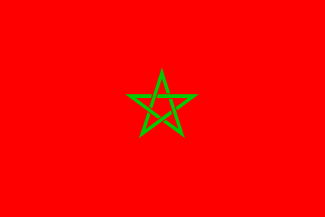Tuesday 10 April 2007
When we wake up in the morning
we discover that the water supply is out of order. After a while we get a bit of
cold water, but the warm water tap will not give us what we so desperately
need. When we check with the front desk they tell us that one of the water
pumps has given the ghost 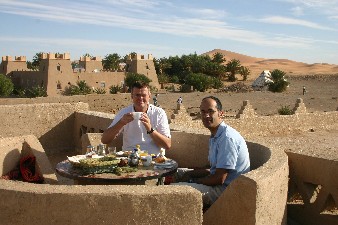 .
We have to settle for a lick and a promise. After breakfast we have to
wait until 10am for the departure of our camel, or rather dromedaries, trek. We
have spotted the animals, but were waiting for the cameliers to join us.
We undertaking this adventure together with a German family from Plauen in
Saxony. The departure is quite an experience. The animal get up to their feet
quite abruptly. You have to hold on to your saddle or else you fall off. First
it stretches its rear legs, which makes roll over forward. Immediately after
that it stands up on its forelegs After a signal from the cameliers the
animals set in motion. It is best to relax and go with the movements of the
animal. We go right into the dunes of Erg Chebbi which begin right behind the
hotel. .
We have to settle for a lick and a promise. After breakfast we have to
wait until 10am for the departure of our camel, or rather dromedaries, trek. We
have spotted the animals, but were waiting for the cameliers to join us.
We undertaking this adventure together with a German family from Plauen in
Saxony. The departure is quite an experience. The animal get up to their feet
quite abruptly. You have to hold on to your saddle or else you fall off. First
it stretches its rear legs, which makes roll over forward. Immediately after
that it stands up on its forelegs After a signal from the cameliers the
animals set in motion. It is best to relax and go with the movements of the
animal. We go right into the dunes of Erg Chebbi which begin right behind the
hotel. 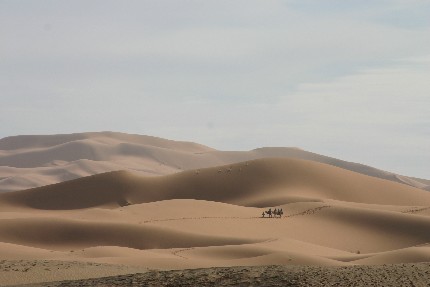 The area is about 28km (18mi) long and 7km (4mi) wide. The dunes are a beautiful
sight. The desert storm has died down completely and the view is perfect. The
Germans babble constantly in their Saxon dialect. After a couple of hours we
reacht a rest camp, where are served with tea and lunch in a tent. Lunch is made
of bread, salad and an omelets. After the break we continue on our trek. We do
not meet any other groups, not even 4x4 jeeps or Quad bikes. That would have
killed the atmosphere badly. It is all very quiet. Our muscles start to hurt,
especially in the groin area. Going downhill is especially hard, uphill the
easiest. The dromedaries are connected head to tail with a small rope. The
camel driver leads the first dromedary.
The area is about 28km (18mi) long and 7km (4mi) wide. The dunes are a beautiful
sight. The desert storm has died down completely and the view is perfect. The
Germans babble constantly in their Saxon dialect. After a couple of hours we
reacht a rest camp, where are served with tea and lunch in a tent. Lunch is made
of bread, salad and an omelets. After the break we continue on our trek. We do
not meet any other groups, not even 4x4 jeeps or Quad bikes. That would have
killed the atmosphere badly. It is all very quiet. Our muscles start to hurt,
especially in the groin area. Going downhill is especially hard, uphill the
easiest. The dromedaries are connected head to tail with a small rope. The
camel driver leads the first dromedary. 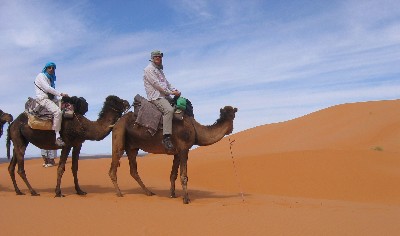 .
There are two drivers. The chat constantly in their Berber language. Most people
in this region is Berber. The Berber ( (or Amazigh, as they like to call
themselves) have lived in Morocco and Algeria long before the arrival of the
Arabs in the 7th century. The took over the Islamic faith, but are less
dogmatic. There are three Berber languages (Tarfit, Tamazight en Teshalhit),
which have recently been officially recognised. Under the previous King the
Berber identity was under pressure, but under the present regime things seem to
have relaxed. The languages, which have their own alphabet, are now - be it
sporadically - taught in schools .
There are two drivers. The chat constantly in their Berber language. Most people
in this region is Berber. The Berber ( (or Amazigh, as they like to call
themselves) have lived in Morocco and Algeria long before the arrival of the
Arabs in the 7th century. The took over the Islamic faith, but are less
dogmatic. There are three Berber languages (Tarfit, Tamazight en Teshalhit),
which have recently been officially recognised. Under the previous King the
Berber identity was under pressure, but under the present regime things seem to
have relaxed. The languages, which have their own alphabet, are now - be it
sporadically - taught in schools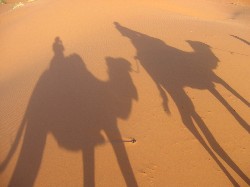 .
As the day progresses, the wind picks up and the sands starts to fly up a bit.
Around 4pm we arrive at a second rest camp, where our German companions will
spend the night. Here we get mint tea and biscuits. The Germans start playing
cards. We have an hour's rest before the final leg of the trek. The camelier
falls asleep and it is already 5.30 when we leave. At 6.15 we stop for a
break to watch the sun set over the desert. The setting sun changes the colours
of the dunes into red and the shadows become longer. After sunset we ride the
final 15 minutes towards the hotel. Contented we say goodbye to Mehmet, the
camelier and go for a shower. The pump has been repaired, but the water pressure
is still very low. Dinner is chicken tajine tonight. Our waiter tries his Dutch
words on us. We are tired and stiff and soon after dinner we retire to our room
. . .
As the day progresses, the wind picks up and the sands starts to fly up a bit.
Around 4pm we arrive at a second rest camp, where our German companions will
spend the night. Here we get mint tea and biscuits. The Germans start playing
cards. We have an hour's rest before the final leg of the trek. The camelier
falls asleep and it is already 5.30 when we leave. At 6.15 we stop for a
break to watch the sun set over the desert. The setting sun changes the colours
of the dunes into red and the shadows become longer. After sunset we ride the
final 15 minutes towards the hotel. Contented we say goodbye to Mehmet, the
camelier and go for a shower. The pump has been repaired, but the water pressure
is still very low. Dinner is chicken tajine tonight. Our waiter tries his Dutch
words on us. We are tired and stiff and soon after dinner we retire to our room
. .
Weer: zonnig, 23 gr.
Avond 18 gr.
Wednesday
11 April 2007
We have breakfast on the sunny
roof top with a view of the dunes. The shower was still not working very well.
It produced a pathetically feeble and tepid stream. After breakfast we are
on our way again. 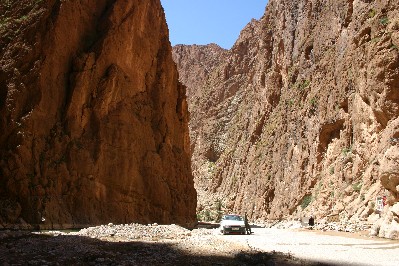 We drive via Risani to Erfoud. Here we withdraw some cash at a ATM and continue
via the rural R3451 towards Tinedjad. There we turn left towards Tinerhir.
Before Tinerhir we have a coffee. At Tinerhir we turn right towards the Todra
gorge. After some 20km (12mi) we reach the gorge. At the beginning of the
gorge we are met by pack of boys offering their services as guides. We decline
and take some photos of the spectacular first part of the gorge. Then we turn
round to get back to the main road. It is possible to drive all the way through
the gorge to the North, but that does not fit in our plans for today.
We drive via Risani to Erfoud. Here we withdraw some cash at a ATM and continue
via the rural R3451 towards Tinedjad. There we turn left towards Tinerhir.
Before Tinerhir we have a coffee. At Tinerhir we turn right towards the Todra
gorge. After some 20km (12mi) we reach the gorge. At the beginning of the
gorge we are met by pack of boys offering their services as guides. We decline
and take some photos of the spectacular first part of the gorge. Then we turn
round to get back to the main road. It is possible to drive all the way through
the gorge to the North, but that does not fit in our plans for today. 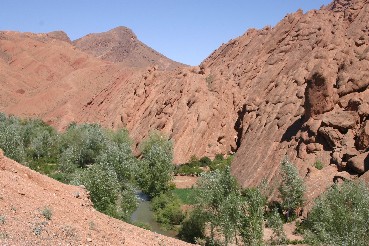 . In
Tinerhir we have lunch at café. The owner tells us the meal will be fresh,
making it sound like a warning. Soon we find out why. Kitchen staff have to go
out and shop for the ingredients before they can start the cooking. Nevertheless
the tajine is on our table within 30 minutes. Glowing hot as so often in
Morocco. After the meal we go on to Boumalne. Here turn off the main road
again to take a look in the Dadès gorge. After some 15km (9mi) we
think that we have moved enough into the beautiful gorge and take some pictures,
while absorbing the beauty of the landscape, its colours and impressive mountain.
We turn back to the main road, and continue our journey via Skoura to Ouarzazate
along the Kasbahroute, as the N10 also is referred to. On our way we see lots of
palmeries, oases and Kashbah's. Not all of them are in good repair (clay is
vulnerable material) and here and there the old houses have been replaced by new . In
Tinerhir we have lunch at café. The owner tells us the meal will be fresh,
making it sound like a warning. Soon we find out why. Kitchen staff have to go
out and shop for the ingredients before they can start the cooking. Nevertheless
the tajine is on our table within 30 minutes. Glowing hot as so often in
Morocco. After the meal we go on to Boumalne. Here turn off the main road
again to take a look in the Dadès gorge. After some 15km (9mi) we
think that we have moved enough into the beautiful gorge and take some pictures,
while absorbing the beauty of the landscape, its colours and impressive mountain.
We turn back to the main road, and continue our journey via Skoura to Ouarzazate
along the Kasbahroute, as the N10 also is referred to. On our way we see lots of
palmeries, oases and Kashbah's. Not all of them are in good repair (clay is
vulnerable material) and here and there the old houses have been replaced by new  brick
ones. On the road we use our mobile (gsm coverage is practically nationwide in
Morocco) to book a room in the Kenzi
Azghor hotel in Ouarzazate. A slightly more expensive tourist hotel
perched on a hill with a beautiful view and pool. brick
ones. On the road we use our mobile (gsm coverage is practically nationwide in
Morocco) to book a room in the Kenzi
Azghor hotel in Ouarzazate. A slightly more expensive tourist hotel
perched on a hill with a beautiful view and pool.
After a short break at the
hotel we go out to visit the Atlas Corporation Film studio. These studios
have been used for years for shooting American and European films and TV series
like Jewel of the
Nile,
Gladiator, Asterix, Ten Commandments and many more. Climate, light and more
importantly low wages for extras draw movie producers to Morocco. Atlas is just
one of four studios here in Ouarzazate.
At night we eat at
Relais de St Exepury, a French run restaurant, which very difficult to find.
After a lot of searching and asking we finally find it near the airport. The
food is a fine mix of Moroccan and French and has a special formula: you choose
the main course and the chef picks entrees and deserts to go along with
it. The walls are plastered with memorabilia regarding the writer of Le Petit Prince,
who was also a aviator, in Morocco and other places in Africa and Europe. After
a good meal among the local expats and tourists we go back to the hotel for a
cocktail at the bar. A two man band has started to play international dance
hits. A coach group invades the dance floor. A sure sign for us to move to our
room.
Weather: sunny, 25°C/77°F. Cooling of in the afternoon to 15°C/59°F.
Donderdag 12 april
2007
During breakfast we have to
deal with an Israeli group, who come to the buffet like a pack of starving
wolves. 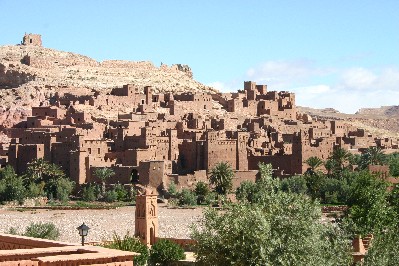 The buffet constantly runs out of food items. A women sits on the ground baking
traditional pancakes. After surviving breakfast we drive in the direction
of Aït Ben Haddou. After 25km we have to turn of the main road to
the village about 9km further on. At the restaurant Le Kasbah we find a huge
parking lot and from there it is a short walk to a almost dried up river bed. We
cross the stream with the help of a few stepping stones and then walk on to the Kasbah Aït Benhaddou.
This is certainly the best preserved and decorated Kasbah in the country. It has
been placed under the protection of Unesco. Most inhabitants have moved
away, their places being taken by shopkeepers and people asking money for a
visit to their homes. We walk up along the winding alleyways towards the
viewpoints. The view of the Kasbah and its surroundings, the palmeries, the
river and the desert is breath taking.
The buffet constantly runs out of food items. A women sits on the ground baking
traditional pancakes. After surviving breakfast we drive in the direction
of Aït Ben Haddou. After 25km we have to turn of the main road to
the village about 9km further on. At the restaurant Le Kasbah we find a huge
parking lot and from there it is a short walk to a almost dried up river bed. We
cross the stream with the help of a few stepping stones and then walk on to the Kasbah Aït Benhaddou.
This is certainly the best preserved and decorated Kasbah in the country. It has
been placed under the protection of Unesco. Most inhabitants have moved
away, their places being taken by shopkeepers and people asking money for a
visit to their homes. We walk up along the winding alleyways towards the
viewpoints. The view of the Kasbah and its surroundings, the palmeries, the
river and the desert is breath taking. 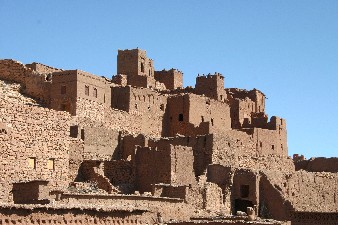 We pay for the visit of a house. A small boy takes us up the roof. He tells us
about what we are seeing (in French). The Kasbah, the sun collectors and that
there are only 10 families left here. He also tells about the many movies that
have been filmed here like Jewel of the Nile, Gladiator, End of Times and
many more. He has only seen Gladiator. You can climb all the way up to a former
granary, where the views are even better. We see that there are indeed not many
people left here in the Kasbah. Most that do live here seem to earn more from
tourism
We pay for the visit of a house. A small boy takes us up the roof. He tells us
about what we are seeing (in French). The Kasbah, the sun collectors and that
there are only 10 families left here. He also tells about the many movies that
have been filmed here like Jewel of the Nile, Gladiator, End of Times and
many more. He has only seen Gladiator. You can climb all the way up to a former
granary, where the views are even better. We see that there are indeed not many
people left here in the Kasbah. Most that do live here seem to earn more from
tourism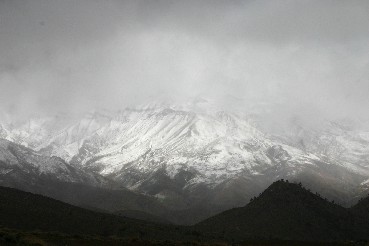 than from the land around the Kasbah. We return to the car park and have some
coffee at restaurant Le Kasbah, with a panoramic view of the Kasbah. We
carry on in the direction of Marrakech. After a while drive in the High Atlas
mountain range. The road steadily climbs until we get above the snow line.
At one point it actually starts snowing! It is a beautiful sight. Up in the
mountains it is icy cold, but nevertheless we see men standing at the road side
trying to sell trinkets and souvenirs. In this area mainly stones and crystals.
In our descent we stop in a tiny village for lunch. It is no more than minced
meat balls
than from the land around the Kasbah. We return to the car park and have some
coffee at restaurant Le Kasbah, with a panoramic view of the Kasbah. We
carry on in the direction of Marrakech. After a while drive in the High Atlas
mountain range. The road steadily climbs until we get above the snow line.
At one point it actually starts snowing! It is a beautiful sight. Up in the
mountains it is icy cold, but nevertheless we see men standing at the road side
trying to sell trinkets and souvenirs. In this area mainly stones and crystals.
In our descent we stop in a tiny village for lunch. It is no more than minced
meat balls 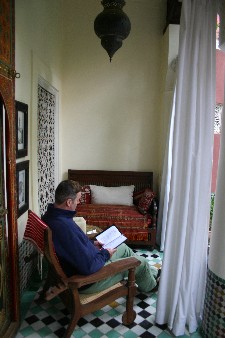 and
bread. No less than seven men are busy serving us. It earns them 68 dh.
Later two coaches make a stop, but most passengers do not buy anything. They
have brought their own food and drinks and are only interested in the
lavatories. We continue along the same road and soon reach lower terrain and
straighter roads. Erik wants to overtake a lorry and crosses the line in the
middle of the road. We are seen by local gendarmes and stopped. and
bread. No less than seven men are busy serving us. It earns them 68 dh.
Later two coaches make a stop, but most passengers do not buy anything. They
have brought their own food and drinks and are only interested in the
lavatories. We continue along the same road and soon reach lower terrain and
straighter roads. Erik wants to overtake a lorry and crosses the line in the
middle of the road. We are seen by local gendarmes and stopped. 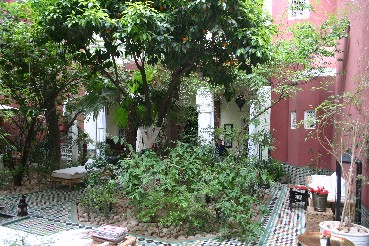 We
have to produce every document thinkable before we get fined 400dh. I demand a
receipt and the policeman takes out his booklet, but in the end we never get the
fine. We get off with a warning. Around 3pm we reach Marrakech. Traffic
is chaotic. We do manage to reach the old town but get stuck in the narrow
alleyways. I get out to go and find our hotel on foot. At one point I have to
engage a couple of boys to lead me to the hotel. We find it and together with a
hotel porter I return to Erik and the car. The porter guides us to a parking lot
closer to the hotel. From there we carry the baggage to our room. We stay
in the Riad
Kaiss. It is a beautifully renovated house in the old town dating back
to 1863. The room (8 in all) are tastefully decorated. It is a luxurious oasis
of silence. There is a little pool on the roof. Downstairs has a hammam. Our
room is next to the patio, which has a couple of orange trees and an moorish
fountain. We
have to produce every document thinkable before we get fined 400dh. I demand a
receipt and the policeman takes out his booklet, but in the end we never get the
fine. We get off with a warning. Around 3pm we reach Marrakech. Traffic
is chaotic. We do manage to reach the old town but get stuck in the narrow
alleyways. I get out to go and find our hotel on foot. At one point I have to
engage a couple of boys to lead me to the hotel. We find it and together with a
hotel porter I return to Erik and the car. The porter guides us to a parking lot
closer to the hotel. From there we carry the baggage to our room. We stay
in the Riad
Kaiss. It is a beautifully renovated house in the old town dating back
to 1863. The room (8 in all) are tastefully decorated. It is a luxurious oasis
of silence. There is a little pool on the roof. Downstairs has a hammam. Our
room is next to the patio, which has a couple of orange trees and an moorish
fountain.
We return the car to Sixt car
rental in the new town, in the Gueliz district, Marrakech's night life
precinct. On our way there we are being stopped again by police, allegedly
because we have jumped a red light. The light was really yellow and we were not
even the last car to cross the street, but the officer does not like to be
talked back to. We have to show all our papers again, but thankfully we get off
with yet another warning. 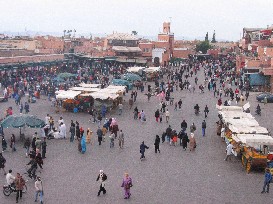 After returning the car we take a taxi back. Early
After returning the car we take a taxi back. Early 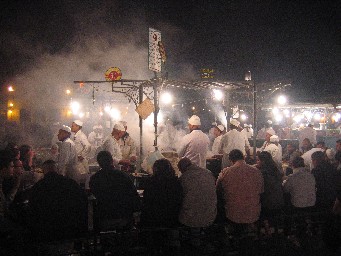 evening
we go out for a drink on the roof top terrace of Hotel CMT on the infamous
and rightly famous Djemaa el Fna square. We enjoy the view of all the
goings on below. The square is not so beautiful at all and looks more the result
of an accident than urban planning. Its charm is chaotic buzz of Moroccans and
tourists. All kinds of merchants show their tricks: snake charmers, story
tellers, musicians, henna painters and many eateries. At the food stalls you can
join the other guests on benches and tables around the stove. We do not. We walk
on through the soukhs North of the square until we get to Café
Arabe. Very trendy joint with good food, professional, be it not too
personal service. We walk back through the soukhs and the square, where food
stalls are in full swing, the story tellers and musician collect their money
before they carry on with their trick. We walk back to the Riad. . evening
we go out for a drink on the roof top terrace of Hotel CMT on the infamous
and rightly famous Djemaa el Fna square. We enjoy the view of all the
goings on below. The square is not so beautiful at all and looks more the result
of an accident than urban planning. Its charm is chaotic buzz of Moroccans and
tourists. All kinds of merchants show their tricks: snake charmers, story
tellers, musicians, henna painters and many eateries. At the food stalls you can
join the other guests on benches and tables around the stove. We do not. We walk
on through the soukhs North of the square until we get to Café
Arabe. Very trendy joint with good food, professional, be it not too
personal service. We walk back through the soukhs and the square, where food
stalls are in full swing, the story tellers and musician collect their money
before they carry on with their trick. We walk back to the Riad. .
Weather: first sunny, but cool.
; 13°C/55°F. Later in the high mountains cloudy, rain and snow; 5°C/41°F. In Marrakech
overcast 20°C/68°F . In the evening cooling to 15°C/59°F.
|
